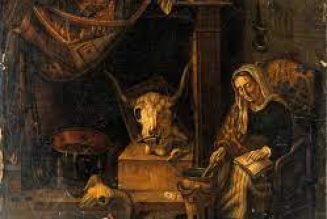In Orphic tradition the Nativity, Epiphany or birth (Genethlia) of Dionysus is celebrated in the evening of 24th December, and is the beginnng of 12 days of ritual worship of Dionysus the Saviour, and with each day one of the Olympian Gods (and their Divine Consorts) is also honoured.
In Orphic myth, Dionysus has two (or three) births hence He is known variously as the Twiceborn (Digonon) or Thriceborn (Trigonon) God.
In His first birth He is born to Persephone, as the infant Zagrefs (Zagreus), sired by Zefs (Zeus).
This first birth is known as the first influence of Zefs. Zefs united with Persephone in the form of a serpent, and from this union Zagrefs was born.
Zefs was pleased with his son and enthroned him, naming Him as his successor, and gave him His thunderbolts and sceptre, and presented him to the Gods as their king.
But, spurred on by the jealousy of Ira (Hera), the Titanes (Titans) smeared their faces with gypsum, and lured Zagrefs away and distracted him, giving him seven toys, referred to as the toys of Dionysos, such that He put down His thunderbolts and was unprotected.
One of these toys was a mirror, and Zagrefs became fascinated by His reflection in the mirror, and whilst he was distracted by His own reflection, the Titanes grabbed him and prepared Him for a sacrifice, cutting Him into pieces with knives, but carefully preserving his heart and limbs.
Then they took the remaining pieces of his flesh and roasted them on spits and each ate a portion.
Zefs smelt the burning flesh and sent Athena to rescue the still beating heart. Athena took the heart of Dionysos Zagrefs to Zefs in a silver casket, and Apollohn took the limbs of the child and interred them at Mount Parnassus.
Zefs then struck the Titanes with a thunderbolt and from their ashes He fashioned the races of mortal beings, who have immortal souls, from the essence of Dionysos Zagrefs, but also the sinful flesh of the Titans and are chained to a sorrowful cycle of births and deaths.
But in His compassion, Zefs also conceived of a solution to the problem of the sufferings of mortal life.
Zefs made a potion from the heart of Zagrefs, and gave it to Saemaeli to drink, and She became pregnant with Dionysos.
Saemaeli was the daughter of Kadmos and Armonia, Armonia being the daughter of Aphrodite and Ares.
Zefs fell in love with Saemaeli and promised to grant her anything she desired. Ira, having discovered the affair between Her husband and the girl, convinced Saemaeli to ask Zeus to appear to her in the same form that he appeared to Ira in.
Zefs was unable to refuse this request because he had made an oath, and appeared with all his lightning and thunder.
Saemaeli was burned up by His divine flames, but wreaths of ivy grew around the babe in her womb, protecting Him from the flames, and Zefs rescued the baby, and sowed him up into his own thigh, until He was ready to be born, to teach the mysteries and free mortals from the cycle of births.
Thus was born Dionysos Aelefthaerefs, Dionysos the Liberator.
It is this second, (or third) birth of Dionysos that we celebrate on 24th December, and it is known as the second influence of Zefs.
The date is set not according to the Roman calendar, but according to to the Hellenic Zodiacal Mystic calendar.
It is the fourth day of the fourth month of the Mystic Year, the month of Aigocaerus, or Capricorn , ruled by Iphaistos, the Smith God who governs the Natural Law of Morphe or form.
It is on this fourth day of the fourth month, which falls on the evening of 24th December, that we celebrate the first appearance of the God in the world, the influence of Zefs on the soul, and fulfilment of Zefs’s divine providence.
On the Twelve Days of Dionysos we recite hymns and make offerings to Dionysos Aelefthaerefs each day, as well as to the Olympian of the day and the divine consort of the Olympian, beginning with Aestia (and Iphaistus), who rules the first Orphic month of Libra on 24th, then Ares (and Aphrodite) on 25th, Artemis (and Apollohn) on 26th, Iphaistos (and Aestia) on 27th, Ira (and Zefs) on 28th, Poseidon (and Demeter) on 29th, Athena (and Aermes) on 30th, Aphrodite (and Ares) on 31st, Apollohn (and Artemis) on 1st January, Aermes (and Athena) on 2nd January, Zefs (and Ira) on 3rd January, and finally, Demeter (and Poseidon) on 4th January.













































